International Marketing Plan: Little Indian Restaurant Analysis
VerifiedAdded on 2022/09/28
|25
|4389
|18
Report
AI Summary
This report details an international marketing plan for Little Indian Restaurant, a Canadian restaurant offering Indian cuisine. It begins with an introduction highlighting the competitive landscape of the Canadian food sector and the importance of strategic marketing in a global business environment. The report identifies Little Indian Restaurant's target market using demographic, geographic, and psychographic variables. It includes a detailed sales forecast for five years, considering units sold, average sales price, cost of goods sold, and annual revenue. Profit forecasts, market penetration, and a SWOT analysis are also provided. The marketing plan outlines the promotion mix, including advertising strategies, media mix, and associated costs. Sales promotion methods, such as coupons, are discussed, along with personal selling and distribution channels. The report addresses the origin and destination ports, mode of transportation, and channel of distribution. Pricing determination, including startup costs, fixed and variable expenses, and breakeven sales levels, are presented. Financial statements, including a forecasted profit and loss account and balance sheet, are provided, along with resource requirements and a conclusion summarizing the key findings and recommendations. Finally, the report refers to various academic sources and includes an appendix with additional data and analysis.
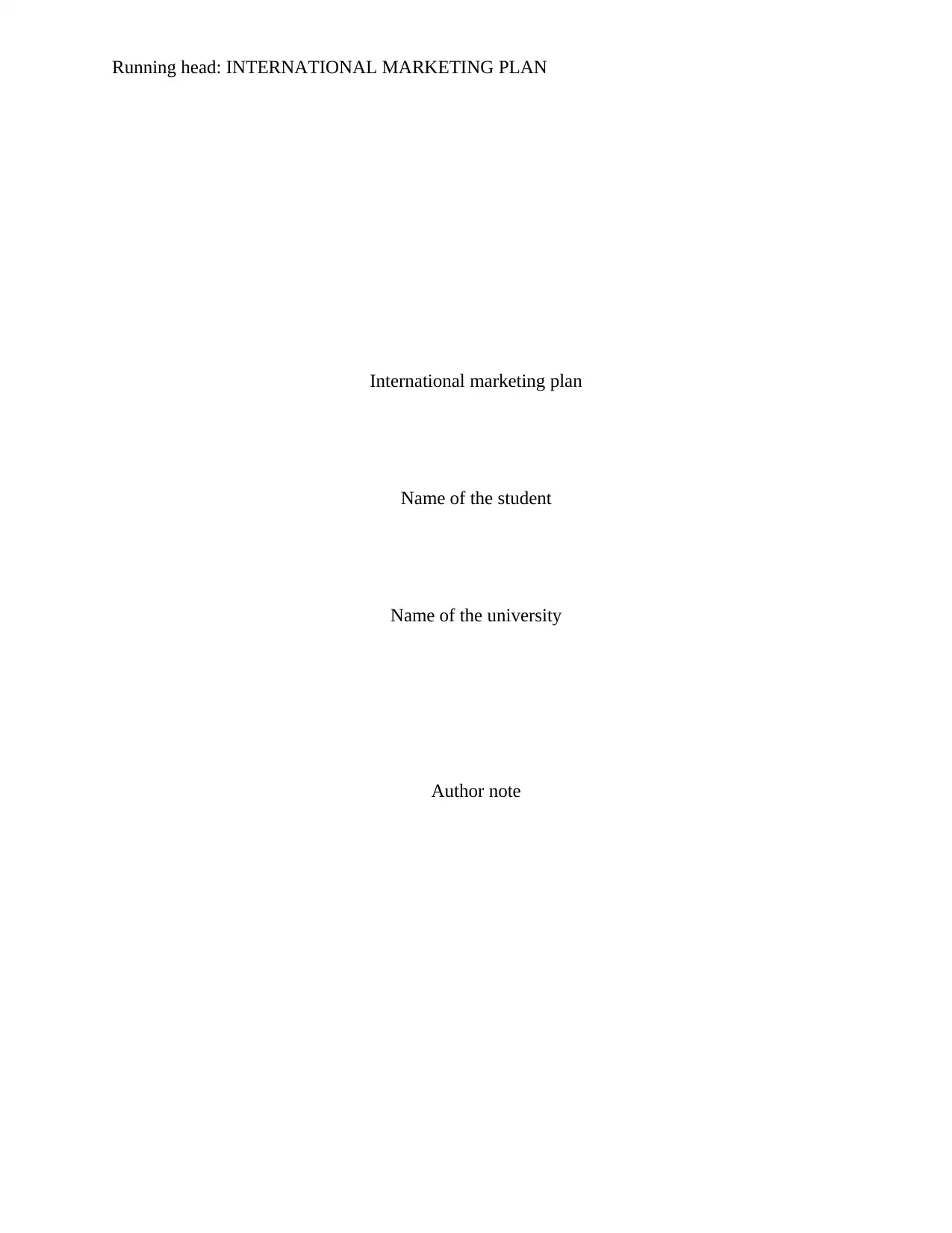
Running head: INTERNATIONAL MARKETING PLAN
International marketing plan
Name of the student
Name of the university
Author note
International marketing plan
Name of the student
Name of the university
Author note
Paraphrase This Document
Need a fresh take? Get an instant paraphrase of this document with our AI Paraphraser
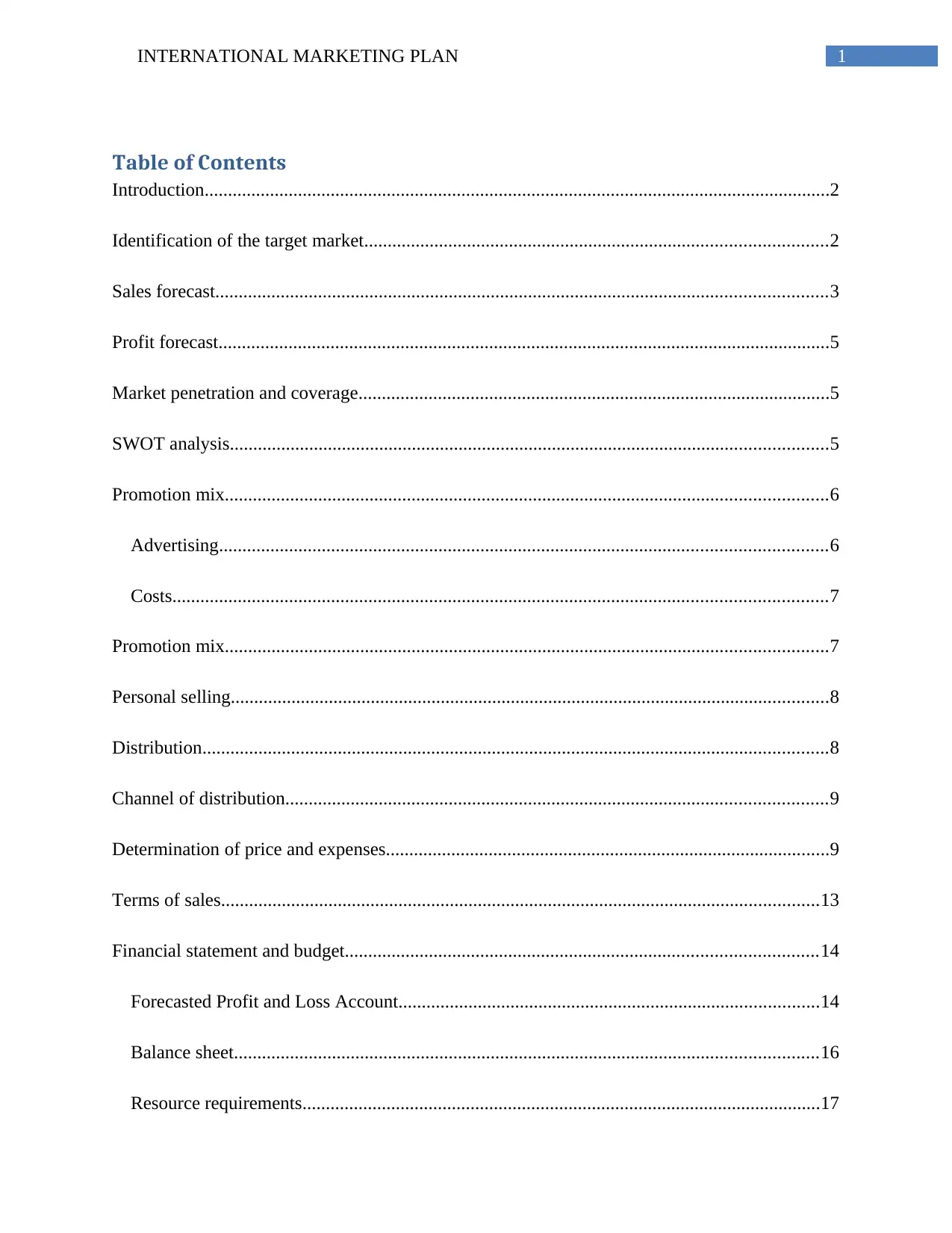
1INTERNATIONAL MARKETING PLAN
Table of Contents
Introduction......................................................................................................................................2
Identification of the target market...................................................................................................2
Sales forecast...................................................................................................................................3
Profit forecast...................................................................................................................................5
Market penetration and coverage.....................................................................................................5
SWOT analysis................................................................................................................................5
Promotion mix.................................................................................................................................6
Advertising..................................................................................................................................6
Costs............................................................................................................................................7
Promotion mix.................................................................................................................................7
Personal selling................................................................................................................................8
Distribution......................................................................................................................................8
Channel of distribution....................................................................................................................9
Determination of price and expenses...............................................................................................9
Terms of sales................................................................................................................................13
Financial statement and budget.....................................................................................................14
Forecasted Profit and Loss Account..........................................................................................14
Balance sheet.............................................................................................................................16
Resource requirements...............................................................................................................17
Table of Contents
Introduction......................................................................................................................................2
Identification of the target market...................................................................................................2
Sales forecast...................................................................................................................................3
Profit forecast...................................................................................................................................5
Market penetration and coverage.....................................................................................................5
SWOT analysis................................................................................................................................5
Promotion mix.................................................................................................................................6
Advertising..................................................................................................................................6
Costs............................................................................................................................................7
Promotion mix.................................................................................................................................7
Personal selling................................................................................................................................8
Distribution......................................................................................................................................8
Channel of distribution....................................................................................................................9
Determination of price and expenses...............................................................................................9
Terms of sales................................................................................................................................13
Financial statement and budget.....................................................................................................14
Forecasted Profit and Loss Account..........................................................................................14
Balance sheet.............................................................................................................................16
Resource requirements...............................................................................................................17

2INTERNATIONAL MARKETING PLAN
Conclusion.....................................................................................................................................18
Reference.......................................................................................................................................19
Appendix........................................................................................................................................21
Conclusion.....................................................................................................................................18
Reference.......................................................................................................................................19
Appendix........................................................................................................................................21
⊘ This is a preview!⊘
Do you want full access?
Subscribe today to unlock all pages.

Trusted by 1+ million students worldwide
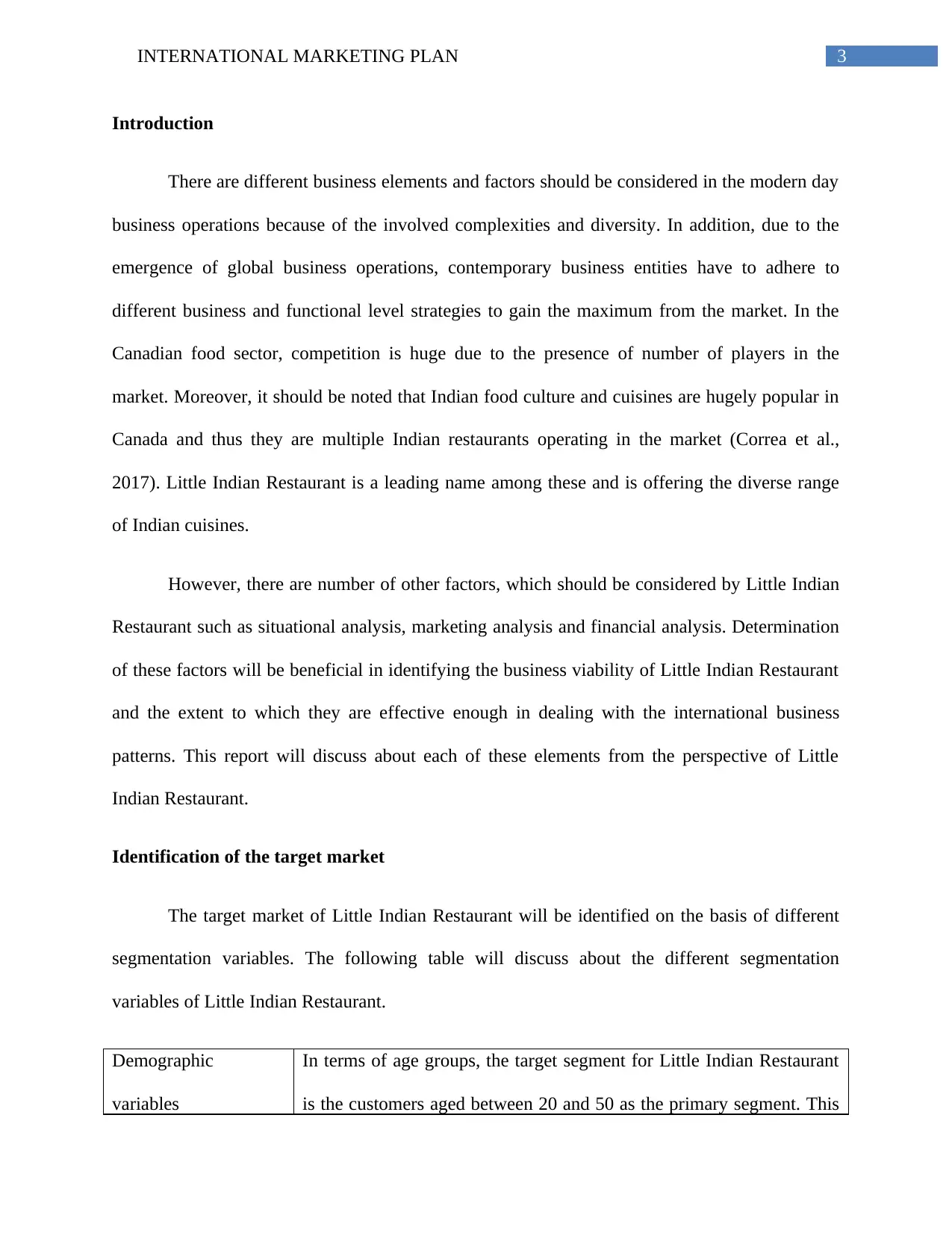
3INTERNATIONAL MARKETING PLAN
Introduction
There are different business elements and factors should be considered in the modern day
business operations because of the involved complexities and diversity. In addition, due to the
emergence of global business operations, contemporary business entities have to adhere to
different business and functional level strategies to gain the maximum from the market. In the
Canadian food sector, competition is huge due to the presence of number of players in the
market. Moreover, it should be noted that Indian food culture and cuisines are hugely popular in
Canada and thus they are multiple Indian restaurants operating in the market (Correa et al.,
2017). Little Indian Restaurant is a leading name among these and is offering the diverse range
of Indian cuisines.
However, there are number of other factors, which should be considered by Little Indian
Restaurant such as situational analysis, marketing analysis and financial analysis. Determination
of these factors will be beneficial in identifying the business viability of Little Indian Restaurant
and the extent to which they are effective enough in dealing with the international business
patterns. This report will discuss about each of these elements from the perspective of Little
Indian Restaurant.
Identification of the target market
The target market of Little Indian Restaurant will be identified on the basis of different
segmentation variables. The following table will discuss about the different segmentation
variables of Little Indian Restaurant.
Demographic
variables
In terms of age groups, the target segment for Little Indian Restaurant
is the customers aged between 20 and 50 as the primary segment. This
Introduction
There are different business elements and factors should be considered in the modern day
business operations because of the involved complexities and diversity. In addition, due to the
emergence of global business operations, contemporary business entities have to adhere to
different business and functional level strategies to gain the maximum from the market. In the
Canadian food sector, competition is huge due to the presence of number of players in the
market. Moreover, it should be noted that Indian food culture and cuisines are hugely popular in
Canada and thus they are multiple Indian restaurants operating in the market (Correa et al.,
2017). Little Indian Restaurant is a leading name among these and is offering the diverse range
of Indian cuisines.
However, there are number of other factors, which should be considered by Little Indian
Restaurant such as situational analysis, marketing analysis and financial analysis. Determination
of these factors will be beneficial in identifying the business viability of Little Indian Restaurant
and the extent to which they are effective enough in dealing with the international business
patterns. This report will discuss about each of these elements from the perspective of Little
Indian Restaurant.
Identification of the target market
The target market of Little Indian Restaurant will be identified on the basis of different
segmentation variables. The following table will discuss about the different segmentation
variables of Little Indian Restaurant.
Demographic
variables
In terms of age groups, the target segment for Little Indian Restaurant
is the customers aged between 20 and 50 as the primary segment. This
Paraphrase This Document
Need a fresh take? Get an instant paraphrase of this document with our AI Paraphraser
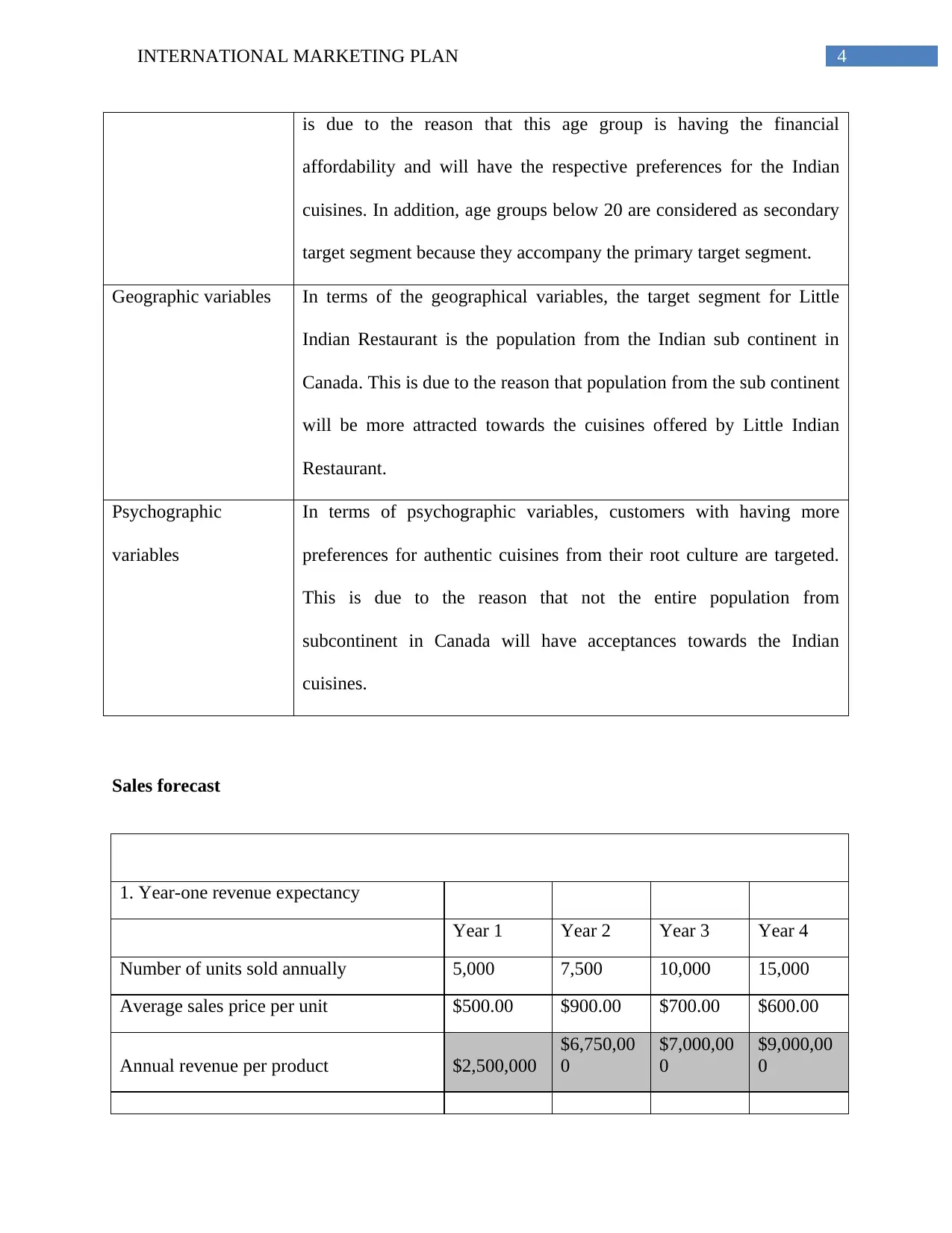
4INTERNATIONAL MARKETING PLAN
is due to the reason that this age group is having the financial
affordability and will have the respective preferences for the Indian
cuisines. In addition, age groups below 20 are considered as secondary
target segment because they accompany the primary target segment.
Geographic variables In terms of the geographical variables, the target segment for Little
Indian Restaurant is the population from the Indian sub continent in
Canada. This is due to the reason that population from the sub continent
will be more attracted towards the cuisines offered by Little Indian
Restaurant.
Psychographic
variables
In terms of psychographic variables, customers with having more
preferences for authentic cuisines from their root culture are targeted.
This is due to the reason that not the entire population from
subcontinent in Canada will have acceptances towards the Indian
cuisines.
Sales forecast
1. Year-one revenue expectancy
Year 1 Year 2 Year 3 Year 4
Number of units sold annually 5,000 7,500 10,000 15,000
Average sales price per unit $500.00 $900.00 $700.00 $600.00
Annual revenue per product $2,500,000
$6,750,00
0
$7,000,00
0
$9,000,00
0
is due to the reason that this age group is having the financial
affordability and will have the respective preferences for the Indian
cuisines. In addition, age groups below 20 are considered as secondary
target segment because they accompany the primary target segment.
Geographic variables In terms of the geographical variables, the target segment for Little
Indian Restaurant is the population from the Indian sub continent in
Canada. This is due to the reason that population from the sub continent
will be more attracted towards the cuisines offered by Little Indian
Restaurant.
Psychographic
variables
In terms of psychographic variables, customers with having more
preferences for authentic cuisines from their root culture are targeted.
This is due to the reason that not the entire population from
subcontinent in Canada will have acceptances towards the Indian
cuisines.
Sales forecast
1. Year-one revenue expectancy
Year 1 Year 2 Year 3 Year 4
Number of units sold annually 5,000 7,500 10,000 15,000
Average sales price per unit $500.00 $900.00 $700.00 $600.00
Annual revenue per product $2,500,000
$6,750,00
0
$7,000,00
0
$9,000,00
0
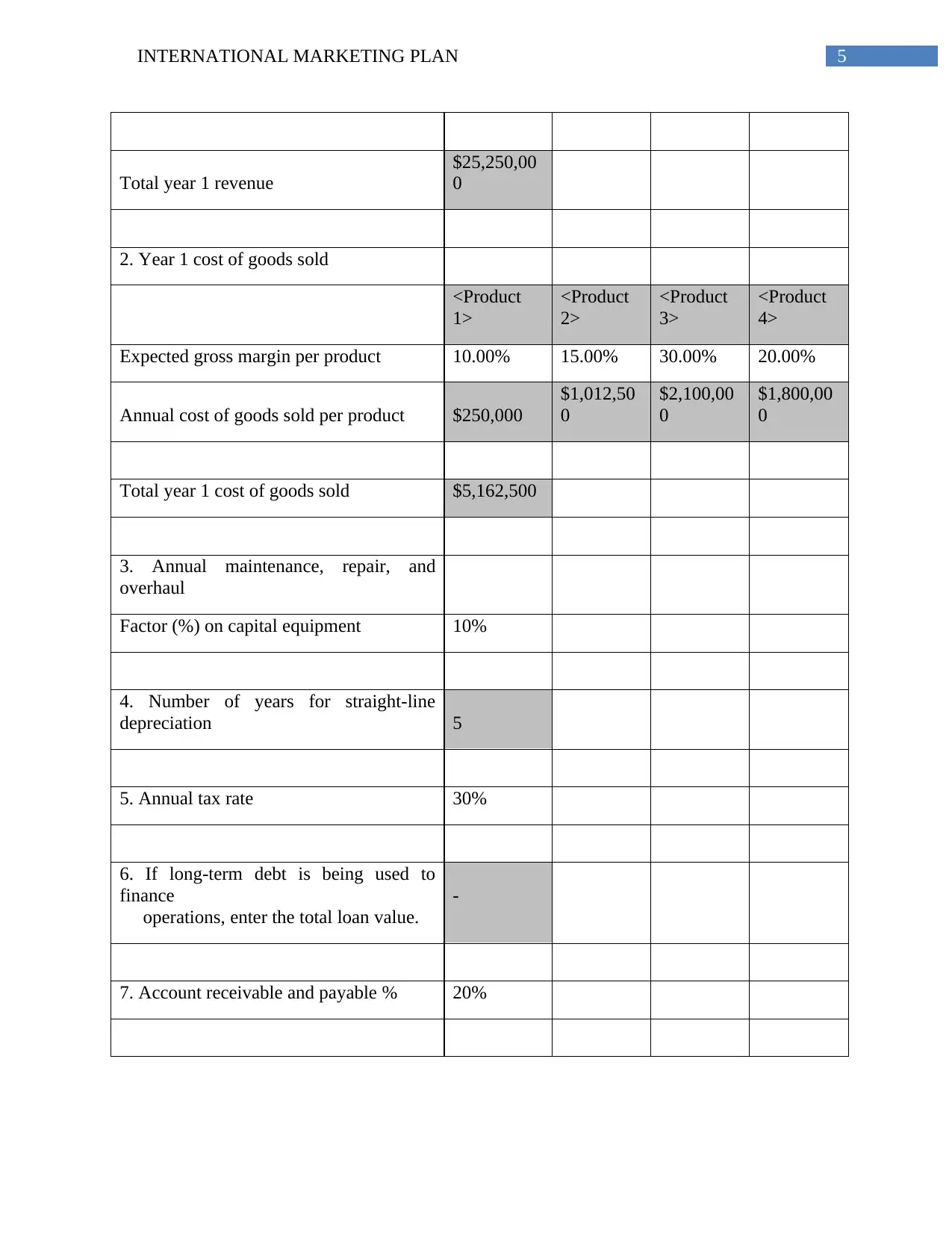
5INTERNATIONAL MARKETING PLAN
Total year 1 revenue
$25,250,00
0
2. Year 1 cost of goods sold
<Product
1>
<Product
2>
<Product
3>
<Product
4>
Expected gross margin per product 10.00% 15.00% 30.00% 20.00%
Annual cost of goods sold per product $250,000
$1,012,50
0
$2,100,00
0
$1,800,00
0
Total year 1 cost of goods sold $5,162,500
3. Annual maintenance, repair, and
overhaul
Factor (%) on capital equipment 10%
4. Number of years for straight-line
depreciation 5
5. Annual tax rate 30%
6. If long-term debt is being used to
finance
operations, enter the total loan value.
-
7. Account receivable and payable % 20%
Total year 1 revenue
$25,250,00
0
2. Year 1 cost of goods sold
<Product
1>
<Product
2>
<Product
3>
<Product
4>
Expected gross margin per product 10.00% 15.00% 30.00% 20.00%
Annual cost of goods sold per product $250,000
$1,012,50
0
$2,100,00
0
$1,800,00
0
Total year 1 cost of goods sold $5,162,500
3. Annual maintenance, repair, and
overhaul
Factor (%) on capital equipment 10%
4. Number of years for straight-line
depreciation 5
5. Annual tax rate 30%
6. If long-term debt is being used to
finance
operations, enter the total loan value.
-
7. Account receivable and payable % 20%
⊘ This is a preview!⊘
Do you want full access?
Subscribe today to unlock all pages.

Trusted by 1+ million students worldwide
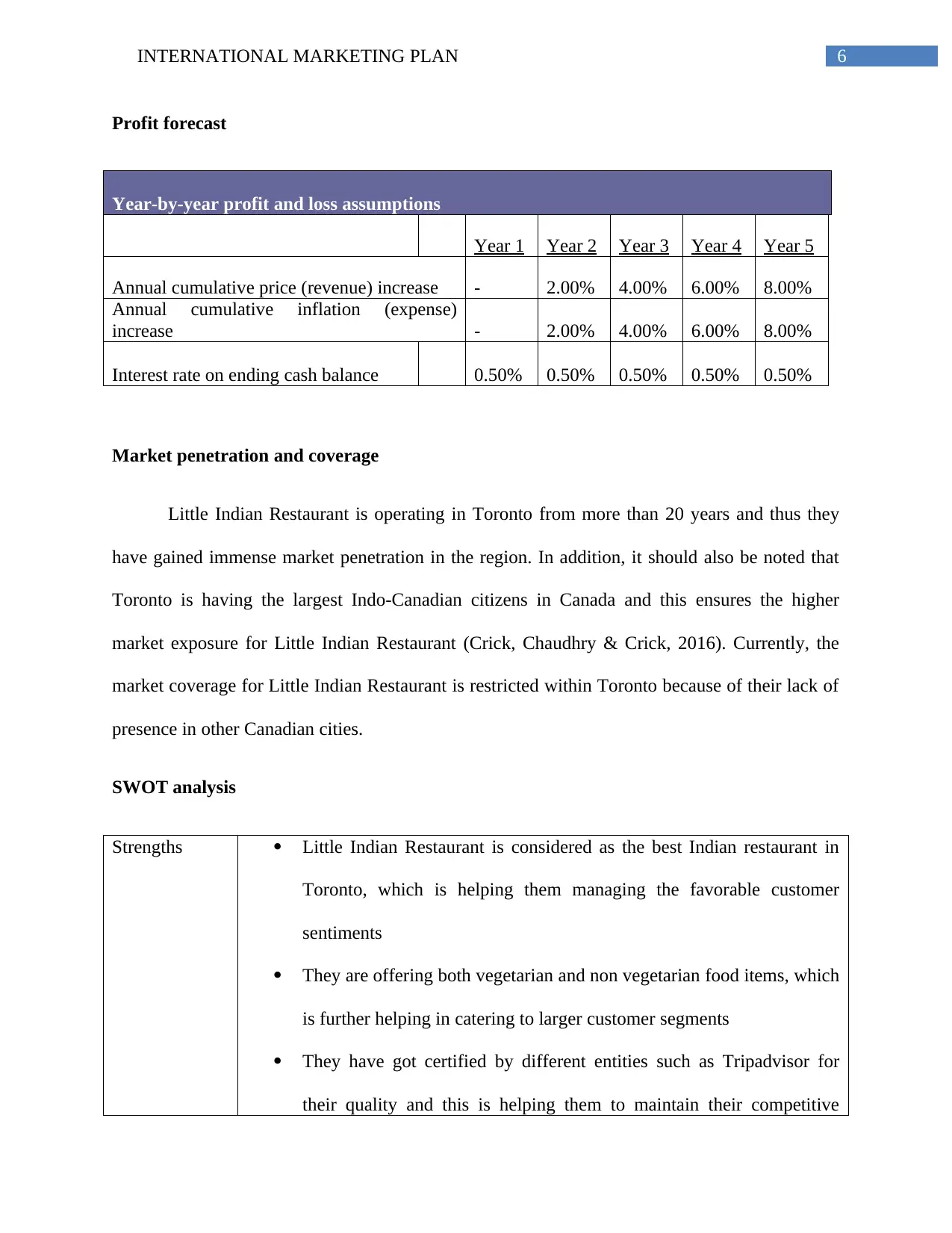
6INTERNATIONAL MARKETING PLAN
Profit forecast
Year-by-year profit and loss assumptions
Year 1 Year 2 Year 3 Year 4 Year 5
Annual cumulative price (revenue) increase - 2.00% 4.00% 6.00% 8.00%
Annual cumulative inflation (expense)
increase - 2.00% 4.00% 6.00% 8.00%
Interest rate on ending cash balance 0.50% 0.50% 0.50% 0.50% 0.50%
Market penetration and coverage
Little Indian Restaurant is operating in Toronto from more than 20 years and thus they
have gained immense market penetration in the region. In addition, it should also be noted that
Toronto is having the largest Indo-Canadian citizens in Canada and this ensures the higher
market exposure for Little Indian Restaurant (Crick, Chaudhry & Crick, 2016). Currently, the
market coverage for Little Indian Restaurant is restricted within Toronto because of their lack of
presence in other Canadian cities.
SWOT analysis
Strengths Little Indian Restaurant is considered as the best Indian restaurant in
Toronto, which is helping them managing the favorable customer
sentiments
They are offering both vegetarian and non vegetarian food items, which
is further helping in catering to larger customer segments
They have got certified by different entities such as Tripadvisor for
their quality and this is helping them to maintain their competitive
Profit forecast
Year-by-year profit and loss assumptions
Year 1 Year 2 Year 3 Year 4 Year 5
Annual cumulative price (revenue) increase - 2.00% 4.00% 6.00% 8.00%
Annual cumulative inflation (expense)
increase - 2.00% 4.00% 6.00% 8.00%
Interest rate on ending cash balance 0.50% 0.50% 0.50% 0.50% 0.50%
Market penetration and coverage
Little Indian Restaurant is operating in Toronto from more than 20 years and thus they
have gained immense market penetration in the region. In addition, it should also be noted that
Toronto is having the largest Indo-Canadian citizens in Canada and this ensures the higher
market exposure for Little Indian Restaurant (Crick, Chaudhry & Crick, 2016). Currently, the
market coverage for Little Indian Restaurant is restricted within Toronto because of their lack of
presence in other Canadian cities.
SWOT analysis
Strengths Little Indian Restaurant is considered as the best Indian restaurant in
Toronto, which is helping them managing the favorable customer
sentiments
They are offering both vegetarian and non vegetarian food items, which
is further helping in catering to larger customer segments
They have got certified by different entities such as Tripadvisor for
their quality and this is helping them to maintain their competitive
Paraphrase This Document
Need a fresh take? Get an instant paraphrase of this document with our AI Paraphraser
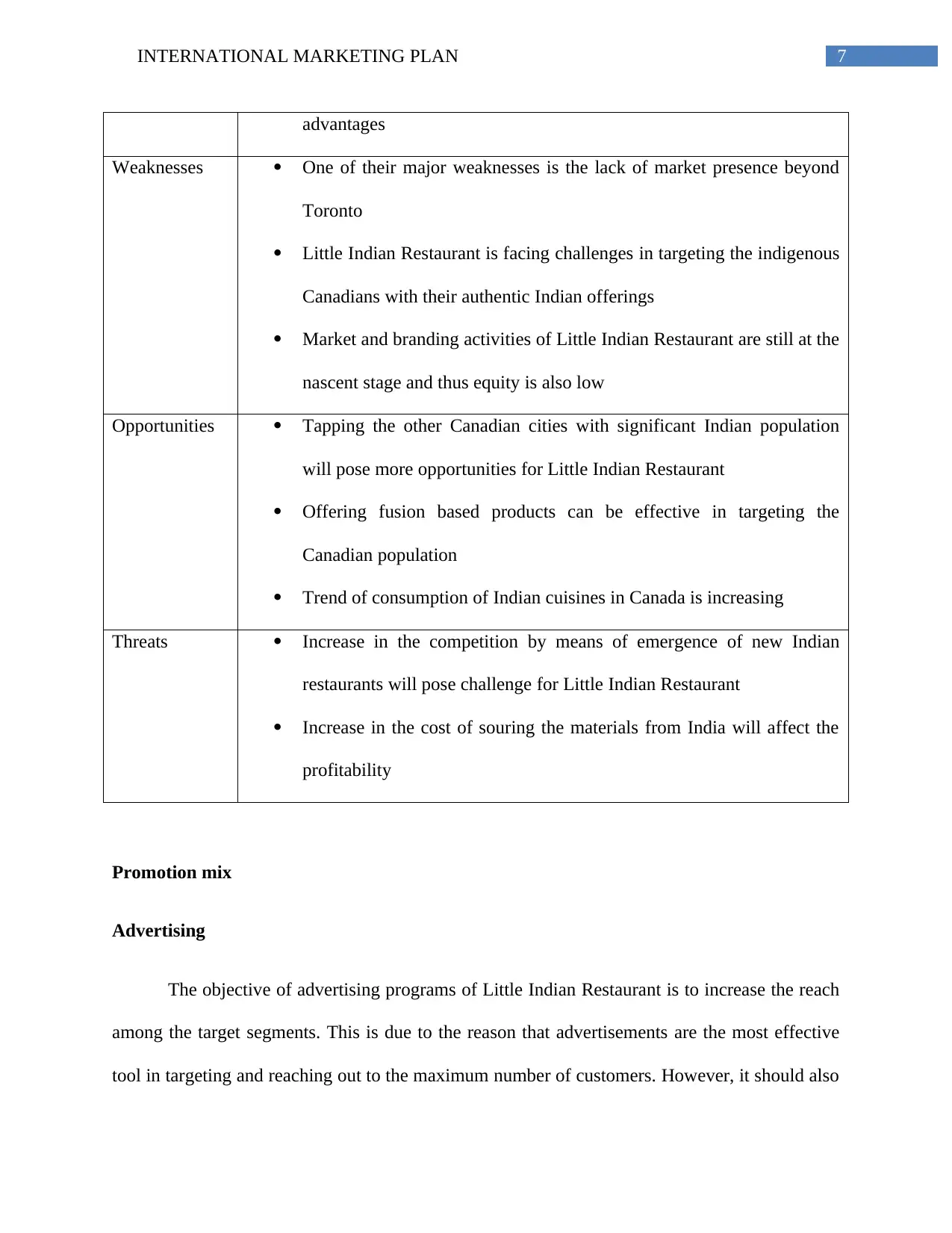
7INTERNATIONAL MARKETING PLAN
advantages
Weaknesses One of their major weaknesses is the lack of market presence beyond
Toronto
Little Indian Restaurant is facing challenges in targeting the indigenous
Canadians with their authentic Indian offerings
Market and branding activities of Little Indian Restaurant are still at the
nascent stage and thus equity is also low
Opportunities Tapping the other Canadian cities with significant Indian population
will pose more opportunities for Little Indian Restaurant
Offering fusion based products can be effective in targeting the
Canadian population
Trend of consumption of Indian cuisines in Canada is increasing
Threats Increase in the competition by means of emergence of new Indian
restaurants will pose challenge for Little Indian Restaurant
Increase in the cost of souring the materials from India will affect the
profitability
Promotion mix
Advertising
The objective of advertising programs of Little Indian Restaurant is to increase the reach
among the target segments. This is due to the reason that advertisements are the most effective
tool in targeting and reaching out to the maximum number of customers. However, it should also
advantages
Weaknesses One of their major weaknesses is the lack of market presence beyond
Toronto
Little Indian Restaurant is facing challenges in targeting the indigenous
Canadians with their authentic Indian offerings
Market and branding activities of Little Indian Restaurant are still at the
nascent stage and thus equity is also low
Opportunities Tapping the other Canadian cities with significant Indian population
will pose more opportunities for Little Indian Restaurant
Offering fusion based products can be effective in targeting the
Canadian population
Trend of consumption of Indian cuisines in Canada is increasing
Threats Increase in the competition by means of emergence of new Indian
restaurants will pose challenge for Little Indian Restaurant
Increase in the cost of souring the materials from India will affect the
profitability
Promotion mix
Advertising
The objective of advertising programs of Little Indian Restaurant is to increase the reach
among the target segments. This is due to the reason that advertisements are the most effective
tool in targeting and reaching out to the maximum number of customers. However, it should also
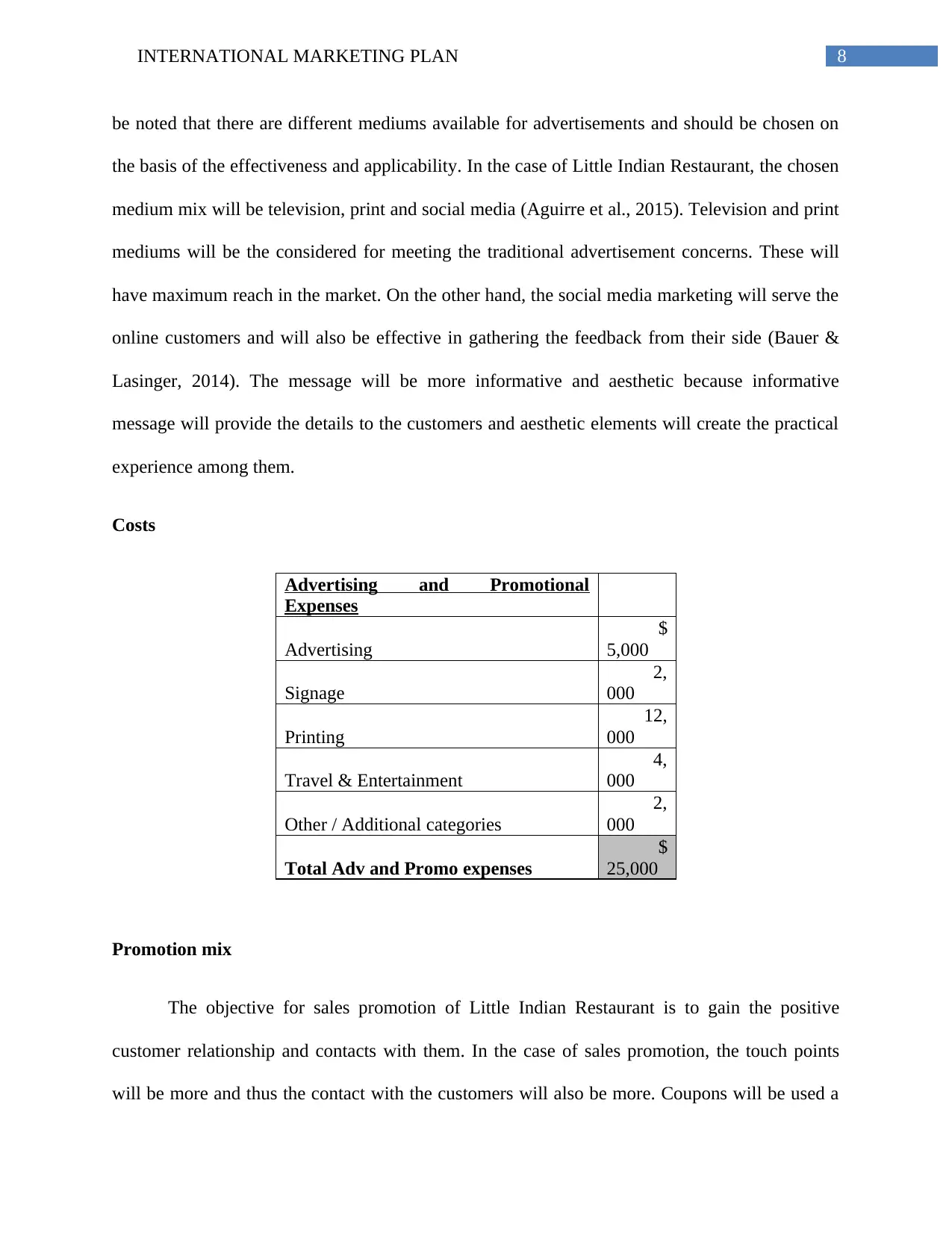
8INTERNATIONAL MARKETING PLAN
be noted that there are different mediums available for advertisements and should be chosen on
the basis of the effectiveness and applicability. In the case of Little Indian Restaurant, the chosen
medium mix will be television, print and social media (Aguirre et al., 2015). Television and print
mediums will be the considered for meeting the traditional advertisement concerns. These will
have maximum reach in the market. On the other hand, the social media marketing will serve the
online customers and will also be effective in gathering the feedback from their side (Bauer &
Lasinger, 2014). The message will be more informative and aesthetic because informative
message will provide the details to the customers and aesthetic elements will create the practical
experience among them.
Costs
Advertising and Promotional
Expenses
Advertising
$
5,000
Signage
2,
000
Printing
12,
000
Travel & Entertainment
4,
000
Other / Additional categories
2,
000
Total Adv and Promo expenses
$
25,000
Promotion mix
The objective for sales promotion of Little Indian Restaurant is to gain the positive
customer relationship and contacts with them. In the case of sales promotion, the touch points
will be more and thus the contact with the customers will also be more. Coupons will be used a
be noted that there are different mediums available for advertisements and should be chosen on
the basis of the effectiveness and applicability. In the case of Little Indian Restaurant, the chosen
medium mix will be television, print and social media (Aguirre et al., 2015). Television and print
mediums will be the considered for meeting the traditional advertisement concerns. These will
have maximum reach in the market. On the other hand, the social media marketing will serve the
online customers and will also be effective in gathering the feedback from their side (Bauer &
Lasinger, 2014). The message will be more informative and aesthetic because informative
message will provide the details to the customers and aesthetic elements will create the practical
experience among them.
Costs
Advertising and Promotional
Expenses
Advertising
$
5,000
Signage
2,
000
Printing
12,
000
Travel & Entertainment
4,
000
Other / Additional categories
2,
000
Total Adv and Promo expenses
$
25,000
Promotion mix
The objective for sales promotion of Little Indian Restaurant is to gain the positive
customer relationship and contacts with them. In the case of sales promotion, the touch points
will be more and thus the contact with the customers will also be more. Coupons will be used a
⊘ This is a preview!⊘
Do you want full access?
Subscribe today to unlock all pages.

Trusted by 1+ million students worldwide
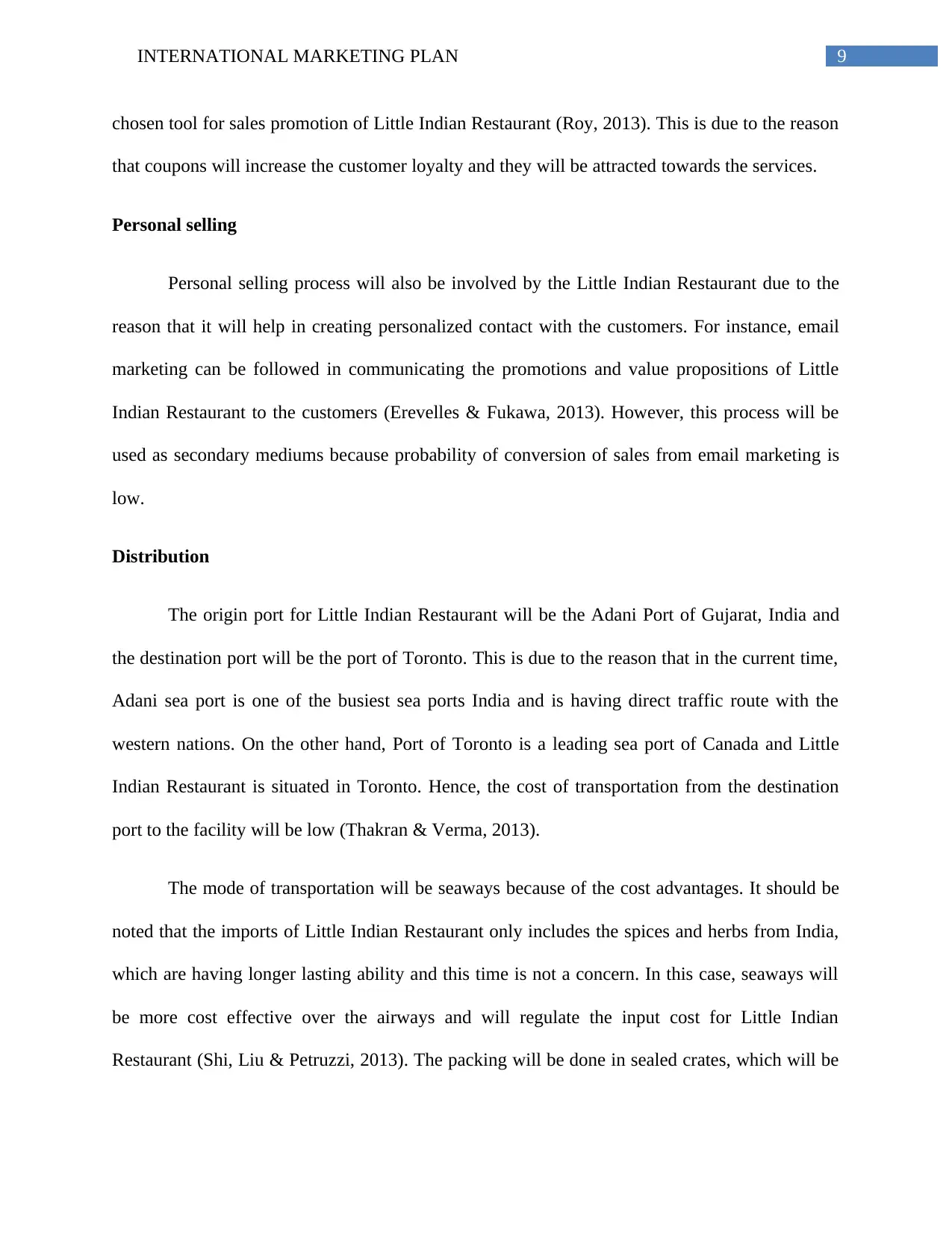
9INTERNATIONAL MARKETING PLAN
chosen tool for sales promotion of Little Indian Restaurant (Roy, 2013). This is due to the reason
that coupons will increase the customer loyalty and they will be attracted towards the services.
Personal selling
Personal selling process will also be involved by the Little Indian Restaurant due to the
reason that it will help in creating personalized contact with the customers. For instance, email
marketing can be followed in communicating the promotions and value propositions of Little
Indian Restaurant to the customers (Erevelles & Fukawa, 2013). However, this process will be
used as secondary mediums because probability of conversion of sales from email marketing is
low.
Distribution
The origin port for Little Indian Restaurant will be the Adani Port of Gujarat, India and
the destination port will be the port of Toronto. This is due to the reason that in the current time,
Adani sea port is one of the busiest sea ports India and is having direct traffic route with the
western nations. On the other hand, Port of Toronto is a leading sea port of Canada and Little
Indian Restaurant is situated in Toronto. Hence, the cost of transportation from the destination
port to the facility will be low (Thakran & Verma, 2013).
The mode of transportation will be seaways because of the cost advantages. It should be
noted that the imports of Little Indian Restaurant only includes the spices and herbs from India,
which are having longer lasting ability and this time is not a concern. In this case, seaways will
be more cost effective over the airways and will regulate the input cost for Little Indian
Restaurant (Shi, Liu & Petruzzi, 2013). The packing will be done in sealed crates, which will be
chosen tool for sales promotion of Little Indian Restaurant (Roy, 2013). This is due to the reason
that coupons will increase the customer loyalty and they will be attracted towards the services.
Personal selling
Personal selling process will also be involved by the Little Indian Restaurant due to the
reason that it will help in creating personalized contact with the customers. For instance, email
marketing can be followed in communicating the promotions and value propositions of Little
Indian Restaurant to the customers (Erevelles & Fukawa, 2013). However, this process will be
used as secondary mediums because probability of conversion of sales from email marketing is
low.
Distribution
The origin port for Little Indian Restaurant will be the Adani Port of Gujarat, India and
the destination port will be the port of Toronto. This is due to the reason that in the current time,
Adani sea port is one of the busiest sea ports India and is having direct traffic route with the
western nations. On the other hand, Port of Toronto is a leading sea port of Canada and Little
Indian Restaurant is situated in Toronto. Hence, the cost of transportation from the destination
port to the facility will be low (Thakran & Verma, 2013).
The mode of transportation will be seaways because of the cost advantages. It should be
noted that the imports of Little Indian Restaurant only includes the spices and herbs from India,
which are having longer lasting ability and this time is not a concern. In this case, seaways will
be more cost effective over the airways and will regulate the input cost for Little Indian
Restaurant (Shi, Liu & Petruzzi, 2013). The packing will be done in sealed crates, which will be
Paraphrase This Document
Need a fresh take? Get an instant paraphrase of this document with our AI Paraphraser
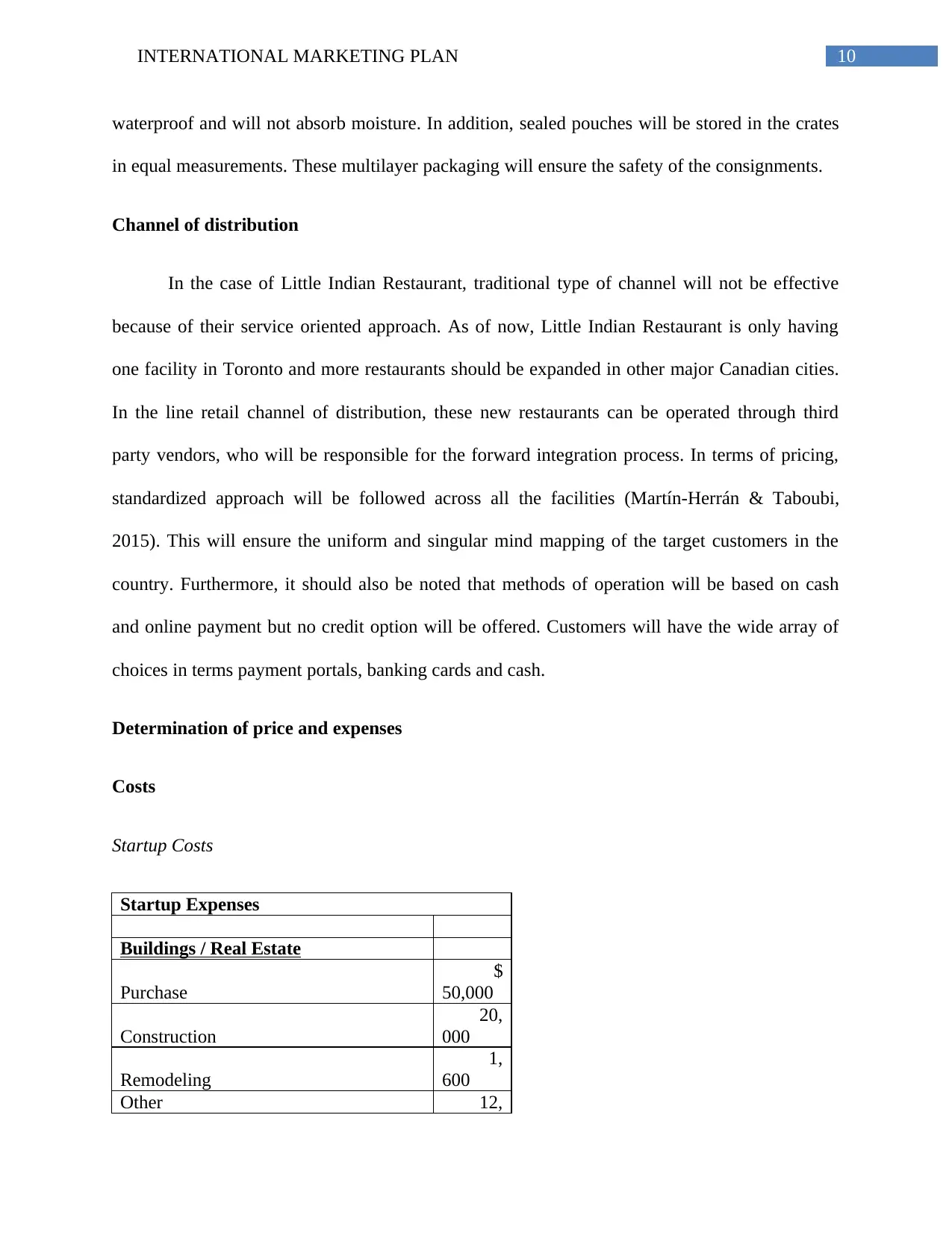
10INTERNATIONAL MARKETING PLAN
waterproof and will not absorb moisture. In addition, sealed pouches will be stored in the crates
in equal measurements. These multilayer packaging will ensure the safety of the consignments.
Channel of distribution
In the case of Little Indian Restaurant, traditional type of channel will not be effective
because of their service oriented approach. As of now, Little Indian Restaurant is only having
one facility in Toronto and more restaurants should be expanded in other major Canadian cities.
In the line retail channel of distribution, these new restaurants can be operated through third
party vendors, who will be responsible for the forward integration process. In terms of pricing,
standardized approach will be followed across all the facilities (Martín-Herrán & Taboubi,
2015). This will ensure the uniform and singular mind mapping of the target customers in the
country. Furthermore, it should also be noted that methods of operation will be based on cash
and online payment but no credit option will be offered. Customers will have the wide array of
choices in terms payment portals, banking cards and cash.
Determination of price and expenses
Costs
Startup Costs
Startup Expenses
Buildings / Real Estate
Purchase
$
50,000
Construction
20,
000
Remodeling
1,
600
Other 12,
waterproof and will not absorb moisture. In addition, sealed pouches will be stored in the crates
in equal measurements. These multilayer packaging will ensure the safety of the consignments.
Channel of distribution
In the case of Little Indian Restaurant, traditional type of channel will not be effective
because of their service oriented approach. As of now, Little Indian Restaurant is only having
one facility in Toronto and more restaurants should be expanded in other major Canadian cities.
In the line retail channel of distribution, these new restaurants can be operated through third
party vendors, who will be responsible for the forward integration process. In terms of pricing,
standardized approach will be followed across all the facilities (Martín-Herrán & Taboubi,
2015). This will ensure the uniform and singular mind mapping of the target customers in the
country. Furthermore, it should also be noted that methods of operation will be based on cash
and online payment but no credit option will be offered. Customers will have the wide array of
choices in terms payment portals, banking cards and cash.
Determination of price and expenses
Costs
Startup Costs
Startup Expenses
Buildings / Real Estate
Purchase
$
50,000
Construction
20,
000
Remodeling
1,
600
Other 12,
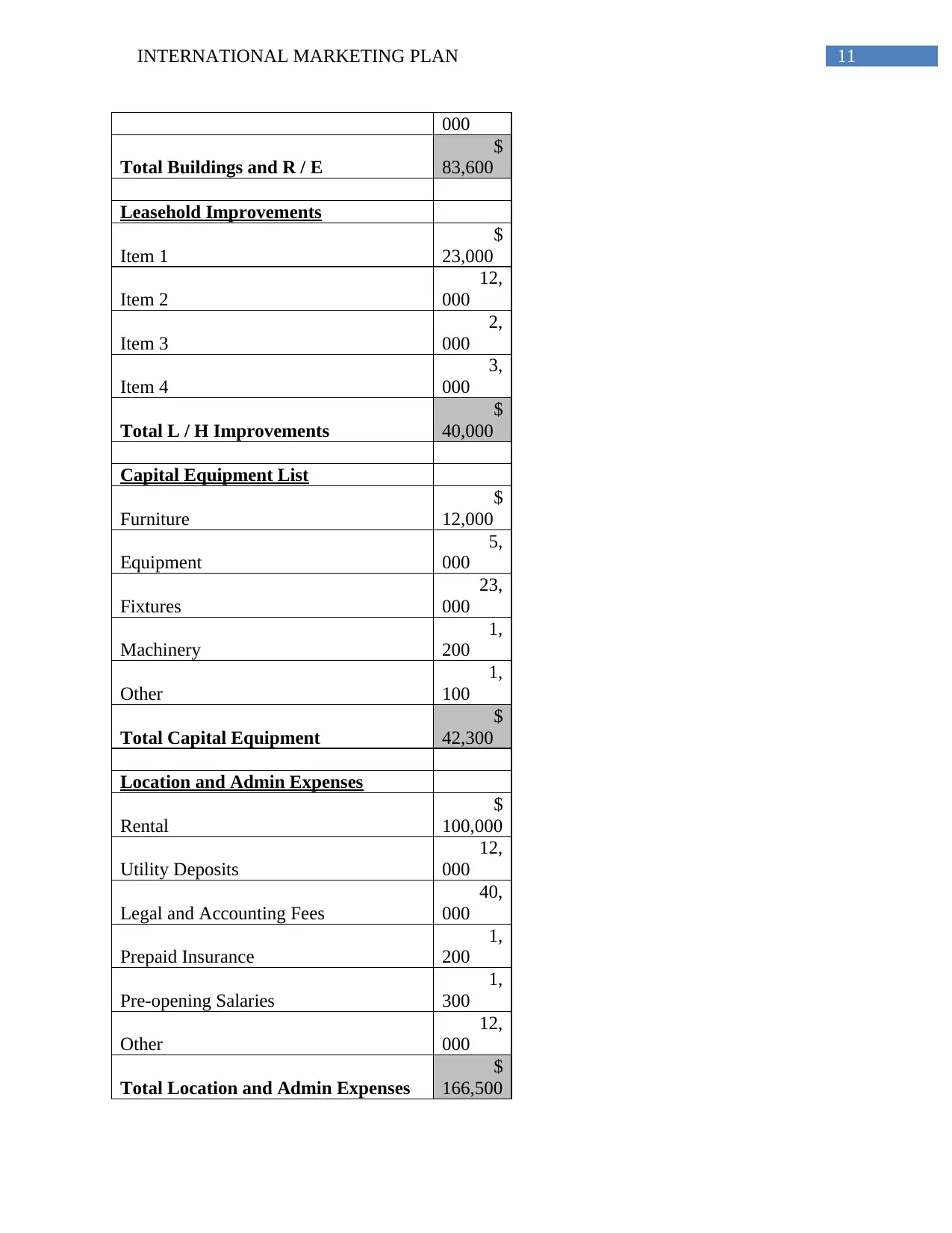
11INTERNATIONAL MARKETING PLAN
000
Total Buildings and R / E
$
83,600
Leasehold Improvements
Item 1
$
23,000
Item 2
12,
000
Item 3
2,
000
Item 4
3,
000
Total L / H Improvements
$
40,000
Capital Equipment List
Furniture
$
12,000
Equipment
5,
000
Fixtures
23,
000
Machinery
1,
200
Other
1,
100
Total Capital Equipment
$
42,300
Location and Admin Expenses
Rental
$
100,000
Utility Deposits
12,
000
Legal and Accounting Fees
40,
000
Prepaid Insurance
1,
200
Pre-opening Salaries
1,
300
Other
12,
000
Total Location and Admin Expenses
$
166,500
000
Total Buildings and R / E
$
83,600
Leasehold Improvements
Item 1
$
23,000
Item 2
12,
000
Item 3
2,
000
Item 4
3,
000
Total L / H Improvements
$
40,000
Capital Equipment List
Furniture
$
12,000
Equipment
5,
000
Fixtures
23,
000
Machinery
1,
200
Other
1,
100
Total Capital Equipment
$
42,300
Location and Admin Expenses
Rental
$
100,000
Utility Deposits
12,
000
Legal and Accounting Fees
40,
000
Prepaid Insurance
1,
200
Pre-opening Salaries
1,
300
Other
12,
000
Total Location and Admin Expenses
$
166,500
⊘ This is a preview!⊘
Do you want full access?
Subscribe today to unlock all pages.

Trusted by 1+ million students worldwide
1 out of 25
Related Documents
Your All-in-One AI-Powered Toolkit for Academic Success.
+13062052269
info@desklib.com
Available 24*7 on WhatsApp / Email
![[object Object]](/_next/static/media/star-bottom.7253800d.svg)
Unlock your academic potential
Copyright © 2020–2025 A2Z Services. All Rights Reserved. Developed and managed by ZUCOL.





